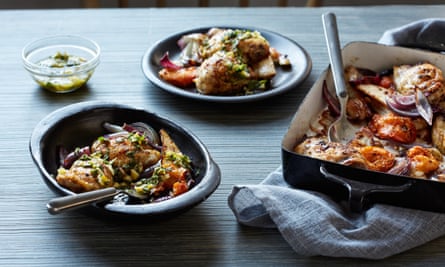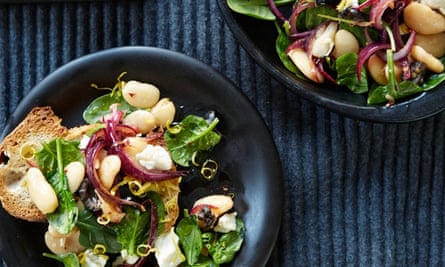Lemon tart
Not much beats this classic pud – creamy, sweet, sharp and crumbly, in just the right amounts, it is the undisputed queen of tarts.
Serves 10–12
140g unsalted butter, at room temperature
250g plain flour, plus extra for dusting
100g icing sugar
30g ground almonds
A pinch of salt
1 egg, lightly beaten
For the filling
5 eggs
4 egg yolks
375g caster sugar
300ml double cream
250ml lemon juice (about 6 large lemons)
1 Cut the butter into small pieces and put it into a large mixing bowl. Add the flour, then, using your fingertips, rub the butter and flour together until you have something that looks like fine breadcrumbs.
2 Add the icing sugar, ground almonds and salt, then mix until you have a fine crumble. Add the egg and bring the dough together with your hands. Pat into a roundish shape, dust with a little flour, then wrap in clingfilm and leave to rest in the fridge for at least half an hour. This relaxes the gluten so you can roll the pastry more easily and it doesn’t shrink in the tin.
3 Preheat the oven to 210C/425F/gas mark 7. Line a deep 30cm tart tin with the pastry and blind bake for about 15 minutes or until firm. Remove from the oven and set aside to cool.
4 Meanwhile, put the filling ingredients into a large bowl and whisk together with a balloon whisk. Set it aside to settle, preferably overnight in the fridge.
5 Preheat the oven again to 140C/275F/gas mark 1. Pour the mixture into the pastry case, then put the tart tin on a baking sheet and bake in the preheated oven for 1 hour.
Margot Henderson, You’re All Invited (Penguin)
Mint and lemon chicken
Our go-to chicken lemon dish, this is also particularly good with apricots (when in season), but just as delicious made without them.

Serves 4-5
1kg chicken thighs (or, if you prefer, a whole chicken cut in pieces)
2–3 large potatoes, peeled and cut into wedges
2 red onions, peeled and cut into 8 wedges each
1 head of garlic, broken into cloves but not peeled
1 lemon, cut in wedges
8–10 fresh apricots, halved (optional)
2 tsp salt
For the marinade
2 tbsp dried mint
1 tsp sumac
1 tsp chilli flakes
1 tsp black pepper
2 tbsp olive oil
For the lemon and mint salsa
2 preserved lemons, chopped
1 small bunch of mint, picked and roughly chopped
2 tbsp olive oil
1 tsp sumac
1 Mix all the marinade ingredients together in a bowl. Add the chicken pieces and stir to coat them thoroughly in the mixture. Cover the bowl and transfer to the fridge to marinate for at least 1 hour, but it’s better to leave it for several hours if you have time.
2 Preheat the oven to 210C/425F/gas mark 7. Put the prepared vegetables and fruit in a large roasting tray and place the chicken pieces on top. Sprinkle the sea salt all over. Roast in the top of the oven for 20 minutes, then mix everything around a little, making sure the fruit and vegetables get coated in the fat at the bottom of the tray. Return to the oven for a further 10–15 minutes until everything is golden and crisp.
3 While the chicken is cooking, mix the salsa ingredients together in a small bowl. Spoon over the hot chicken pieces before serving.
Itamar Srulovich and Sarit Packer, Honey and Co (Saltyard)
Lemon rice
This very simple, deeply savoury rice dish is lifted by the juice of no less than three lemons. Serve with a dollop of yoghurt.
Serves 4–6
400g basmati rice
3 tbsp vegetable or corn oil
1 tbsp mustard seeds
1 tbsp chana dhal (split yellow chickpeas)
1 tsp white urad lentils (optional)
20 fresh curry leaves
1 tsp ground turmeric
1½ tsp salt
Juice of 3 lemons
1 Wash the rice in plenty of cold water, then leave it to soak in more clean, cold water. Drain. Bring 1 litre of water to the boil in a saucepan and add the rice. Cook uncovered, for 8–10 minutes, until the grains are tender, then drain and set aside.
2 Heat the oil in a large pan. Add the mustard seeds, chana dhal and urad lentils, and let them crackle. When the dhal and lentils start to turn golden, add the curry leaves and turmeric, and stir for 1 minute. You could need to sprinkle in water to prevent the turmeric burning.
3 Add the cooked rice, salt and lemon juice and toss gently to mix. Serve immediately.
Vivek Singh, cinnamonclub.com
Lemony lava cakes
Molten lemon curd erupts from these six, light lemony sponges. Serve with a dollop of creme fraiche. The leftover lemon curd is great swirled through yoghurt.
Makes 6
For the sponge
100g soft unsalted butter, plus extra for greasing
80g caster sugar, plus 1 tbsp for dusting
2 eggs
2 tbsp whole milk
Zest of 3 lemons
100g plain flour
For the lemon curd
Juice of 3 lemons (about 110ml)
200g caster sugar
2 eggs
A pinch of sea salt
50g cold unsalted butter, cubed
1 Place all the ingredients for the lemon curd, apart from the butter, in a medium saucepan on a gentle heat and whisk continuously for 5-8 minutes, or until the mixture thickens.
2 Whisk in the butter, cube by cube. Take off the heat once all the butter has completely melted. Pour into a wide bowl and cool for around 20-30 minutes, or until it reaches room temperature. Pour into a disposable piping bag or a heavy-duty food bag, and refrigerate until ready for use.
3 Preheat the oven to 200C/400F/gas mark 6. Butter six ramekins and dust them with sugar.
4 To make the sponge, beat the butter and sugar until fluffy. Lightly beat the eggs and gradually add them to the mix, beating all the time, followed by the milk and lemon zest.
5 Sift the flour into the mix and incorporate well. Divide the cake batter between the ramekins until each is just over half full.
6 Take the piping or food bag and snip off the corner. Insert the tip into the centre of each batter-filled ramekin. Pipe the curd into each one until the ramekins are two-thirds full. Place them on a baking tray.
7 Bake for 15-20 minutes, or until the tops are golden and spring back when touched.
8 Immediately run a knife around the edges of the cakes before turning out from the ramekins on to plates. Serve straight away.
Rachel Khoo’s Kitchen Notebook (Michael Joseph)
Lemony olive oil
This bright, citrussy oil is a wonderful condiment to drizzle over a bowl of grains, roast veg or a medley of green leaves.
Makes around 500ml
A few sprigs of thyme
1 head of garlic
3 strips of lemon zest
500ml olive oil
1 First, dry the thyme by putting the herbs on a baking tray lined with baking parchment and placing it in an oven set to 110C/225F/gas mark ¼, or on the lowest setting you have. Leave the door slightly ajar and bake for about 20 minutes. Remove and set aside.
2 Remove and peel all the cloves from the head of the garlic. Put the garlic, lemon zest and olive oil in a wide, heavy bottomed saucepan. Warm the oil, zest and garlic over a very low heat setting, never bringing it to a simmer, for about 30 minutes.
3 Leave the oil to cool before decanting it into a jar along with the dried thyme. It will keep for about 2 weeks.
Georgina Hartley, fromthelarder.co.uk
Quick preserved lemons
Preserved lemon brings a fragrant shard of citrus to aromatic tagines, warm salads or even a twist on ceviche.

Makes 1 bowl
4 lemons
1 tbsp sea salt
2 tsp sugar
½ tsp dill or coriander seeds, lightly toasted
A pinch of chilli flakes (optional)
1 Slice two of the lemons as thinly as you can. Juice the other two lemons and mix the juice with the salt and sugar.
2 Arrange the lemon slices on the bottom of a Tupperware dish and pour the seasoned lemon juice over the top. Sprinkle over the seeds and flakes if using. Leave to rest overnight.
Olia Hercules, oliahercules.com
Butter bean and feta salad
Lemon juice and zest pep up this assemblage of melt-in-the-mouth butter beans and crumbled cheese.

Serves 2
1 tbsp extra virgin olive oil, plus a drizzle
1 red onion, sliced
½ tsp chilli flakes
400g can of butter beans, drained
A handful of black olives, stoned, drained and torn
100g baby spinach
100g feta, crumbled
Juice and zest 1 lemon
½ garlic clove, crushed
Salt and black pepper
1 Heat the olive oil in a large frying pan over a medium high heat, add the onion and fry for 2 minutes, until just starting to cook. Add the chilli flakes, butter beans and olives. Stir and allow to heat through.
2 Put the spinach on to serving plates or a platter. Tip the butter-bean mix on top and toss to combine the ingredients. Crumble over the feta.
3 Mix the lemon zest and juice with the garlic, some seasoning and an extra glug of oil. Pour this over the salad and serve immediately.
Rosie Reynolds, rosiereynolds.co.uk
Avgolemono
This Mediterranean soup is a beautifully restorative combination of egg and lemon. Serve it plain and simple, as below, or alternatively, throw a handful of cooked orzo and picked chicken into the pan for a more substantial meal.
Serves 4
1.2 litres chicken stock
4 eggs
Juice of 1 large lemon
Thin slices of lemon and sprigs of dill, to garnish
1 Bring the chicken stock to the boil. Beat the eggs in a bowl with the lemon juice.
2 Gradually add a little of the stock to the eggs, beating well. Return to the pan and cook until it is the consistency of a thin custard – but be careful not to let it get anywhere near boiling point.
3 Serve hot or chilled: hot it tastes more chickeny; cold, more lemony. Either way, float a thin slice of lemon in the bowl and top with a feathery sprig of dill.
Margaret Costa, Four Seasons Cookery Book (Grub Street)
Lemon barley water
An old-fashioned cooler made from the cooking liquor left over from a pot of boiled barley. See our 10 best barley recipes for an idea of what to do with the grains ...
Makes about 2 litres
225g pearl barley
2.5 litres water
Zest and juice of 5 lemons
200g caster sugar
A handful of mint sprigs
1 Rinse the pearl barley, cover with the water and bring to the boil, then reduce the heat and cook gently for up to 1 hour or until the barley has become tender.
2 Meanwhile, place the zest in a bowl with the caster sugar. Take the cooked barley and strain, pouring the liquid over the lemon zest and sugar, stirring so all the sugar dissolves.
3 Let the liquid and lemon zest steep for an hour, or until cooled. Then add the lemon juice and some sprigs of mint. Store in the fridge and either drink neat or add water to taste. This will keep in the fridge, covered, for a day or so.
Ian James, Nicholas Selby and Louisa Chapman-Andrews: Melrose and Morgan’s Good Food For Your Table (Saltyard)
Roasted lemon, purple sprouting broccoli with salted anchovies salad
The simplicity of this dish and strong disparate flavours warrant high quality ingredients. If you can, seek out amalfi lemons, which are good enough to eat raw like an apple, and use whole Spanish anchovies packed in salt. This salad can be served warm or at room temperature.
Serves 4
1 unwaxed organic lemon
400g purple sprouting broccoli, largest stems cut in half lengthways
2 sprigs rosemary, picked
2 tbsp extra virgin olive oil
2 whole anchovies packed in salt, fillets carefully removed, torn into large pieces
Salt and black pepper
1 Preheat the oven to 190C/375F/gas mark 5. Cut the lemon into thin slices. Be sure to use the lemon tops and bottoms too – the pith tastes absolutely delicious once it’s been properly roasted.
2 Toss the lemon slices, purple sprouting broccoli and rosemary leaves in the olive oil along with a little salt and black pepper. Spread the slices evenly over a baking tray so they cook evenly in the oven. Roast for about 15-20 minutes until charred, but not too soft. Remove and set aside.
3 When you are ready to eat, arrange the lemon and broccoli on a large platter scattered with the anchovies.
Tom Hunt, The Natural Cook (Quadrille)

Comments (…)
Sign in or create your Guardian account to join the discussion